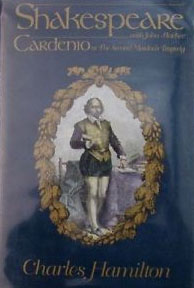 In 1994, Charles Hamilton published Cardenio, or the Second Maiden’s Tragedy. Using his expertise as a handwriting analyst, Hamilton first concluded that William Shakespeare had written his own will (by comparing it to his signatures). Hamilton then used the handwriting on the will to conclude that Shakespeare had written the manuscript for The Second Maiden’s Tragedy.
In 1994, Charles Hamilton published Cardenio, or the Second Maiden’s Tragedy. Using his expertise as a handwriting analyst, Hamilton first concluded that William Shakespeare had written his own will (by comparing it to his signatures). Hamilton then used the handwriting on the will to conclude that Shakespeare had written the manuscript for The Second Maiden’s Tragedy.
I’m not a handwriting expert, so it’s impossible for me to comment on the veracity of Hamilton’s conclusions regarding the handwriting of the Second Maiden’s Tragedy manuscript. To an amateur like myself it certainly seems possessed of a certain weight, although I can’t help noticing that — despite the great quantities of verbiage Hamilton expends upon the subject — his actual evidence boils down to two comparative tables of selected words and a complete alphabet from Shakespeare’s will and the Second Maiden’s Tragedy manuscript (pg. 139-140).
This relative paucity of evidence may be surprising when you look over the sheer number of pages which Hamilton ostensibly dedicates to the purpose. But most of this material is dedicated to Hamilton either touting his own credentials in lieu of providing actual evidence or in the discussion of tangential and irrelevant topics.
For example, Hamilton mentions the fact that, as a forensics document expert, he compares 24 distinctive characteristics of handwriting in order to make an identification. But while he blindly asserts his own authority to claim that all 24 of these characteristics match between Shakespeare’s will and the Second Maiden’s Tragedy manuscript, Hamilton never actually demonstrates any of this. (Instead he performs some incredibly bogus and hilariously deceptive mathematical operations in an effort to prove that there’s only a 1 in 55,844,879,025,390,625 probability of two people having the same handwriting. But in doing so he ignores that this would (a) require a 100% certain identification on every single characteristic (which isn’t possible); (b) that many or all of these characteristics exist along a sliding scale of variation in each person’s handwriting; and (c) that there may be a statistical and causal association between different characteristics of writing (the way a person shapes their letters, for example, might have a consistent and similar impact on the spacing between their letters). This kind of blatant intellectual dishonesty in his own area of expertise makes me hesitant to take anything Charles Hamilton says at face value.)
To sum up: If you’re willing to accept Charles Hamilton’s word for it, then the manuscript for The Second Maiden’s Tragedy and Shakespeare’s will were both written by the same person. That conclusion, by itself, raises several interesting questions and a number of intriguing avenues of investigation.
Which brings us to Hamilton’s second major claim: That The Second Maiden’s Tragedy is specifically the lost play of Cardenio, written by William Shakespeare and John Fletcher.
Originally posted August 2010.












